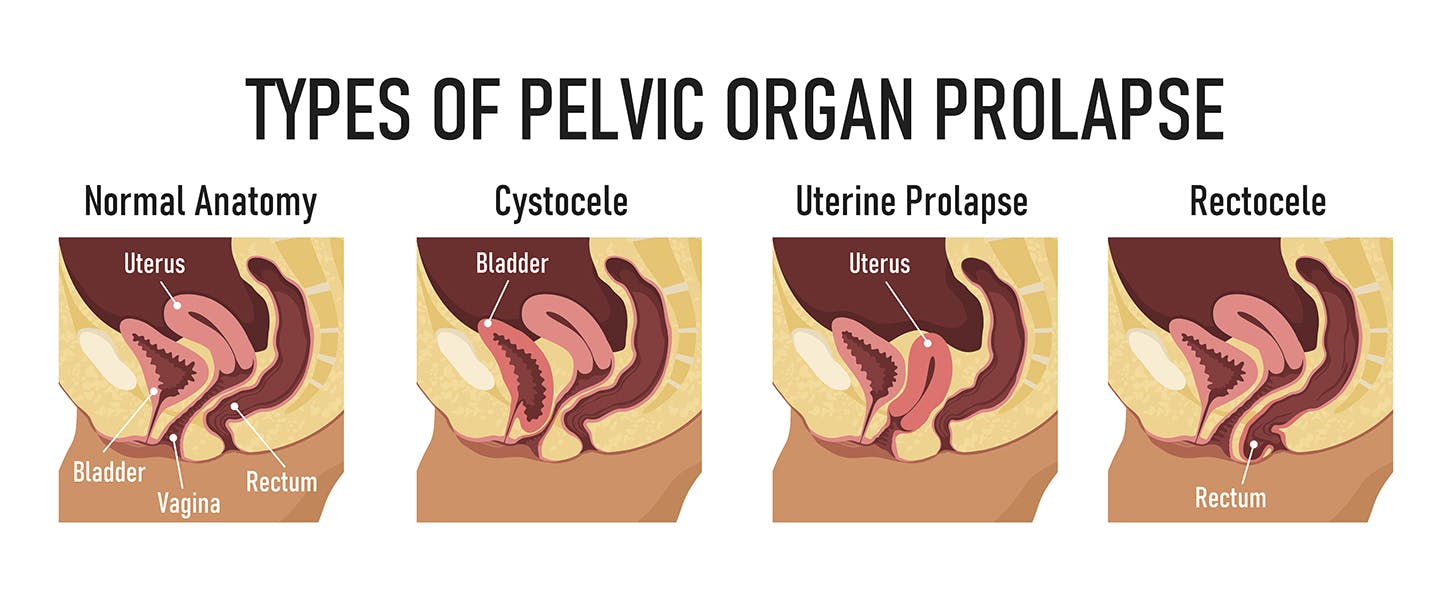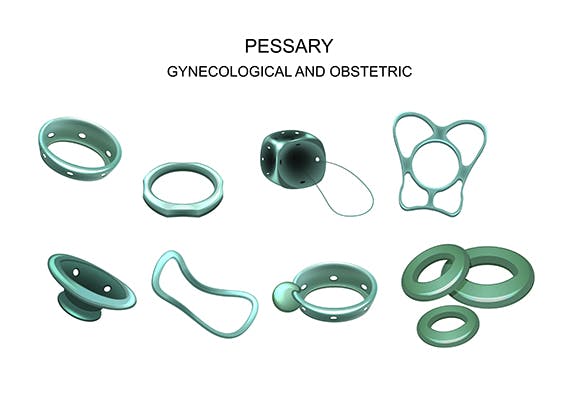What is Pelvic Organ Prolapse?
Pelvic organ prolapse occurs when a pelvic organ — such as your bladder or uterus — drops (prolapses) from its normal place in your lower belly and pushes against the walls of your vagina. This can happen when the muscles that hold your pelvic organs in place become weak or stretched.
Many women will have some kind of pelvic organ prolapse. It can be uncomfortable or painful, but is not typically a serious health problem. It doesn’t always get worse, and it has been shown that with work it can get better!
More than one pelvic organ can prolapse at the same time. Organs that can be involved when you have pelvic prolapse include the bladder, rectum, uterus, urethra or small intestine.
A bladder prolapse (cystocele) is most common, and occurs when the tissues that hold the bladder in place are stretched or weakened. This causes the bladder to move from its normal position and press against the front wall of the vagina, forming a bulge.
A uterine prolapse occurs when a woman’s pelvic muscles and ligaments become weak, allowing the uterus to drop from its normal position and the cervix to bulge into the vagina.
A rectocele occurs when the tissues and muscles holding the end of the large intestine (rectum) are stretched or weakened, allowing the rectum to move from its regular position and press against the back wall of the vagina.
What Causes Pelvic Organ Prolapse?
Pelvic organ prolapse is commonly linked to straining during childbirth, although some women who have never had children can develop a prolapse. Women after menopause can develop a prolapse as the ligaments and support system do not effectively hold the pelvic organs as they once did.
People generally ignore their pelvic floor muscles, and move around against gravity every day—over time, very weak muscles will allow organs to sit lower due to stretching of the supporting structures.
Other causes:
- Aging
- Extra weight
- Heavy lifting
- Smoking
- Constipation
- Hysterectomy
- Coughing
- High impact activities
- Caffeine and other irritants
What Are the Symptoms of Pelvic Organ Prolapse?
Symptoms of pelvic organ prolapse include:
- Feeling pressure or heaviness from pelvic organs pressing against the vaginal wall. This is the most common symptom.
- Feeling very full in your lower belly.
- Feeling as if something is falling out of your vagina.
- Feeling a pull or stretch in your groin area or pain in your lower back.
- Releasing urine without meaning to (incontinence), or needing to urinate frequently
- Having pain in your vagina during sex.
- Having problems with your bowels, such as constipation.
How is Pelvic Organ Prolapse Diagnosed?
Your doctor will ask questions about your symptoms and about any pregnancies or health problems. Your doctor or pelvic health physiotherapist will also do a physical exam, which will include a pelvic exam, in order to assess the walls of your vagina and if your bladder or uterus have descended at all.
How Is It Treated?
Decisions about your treatment will be based on which pelvic organs have prolapsed and how you are feeling.
There is much that can be done to improve your prolapse!
You will need to work with a physiotherapist who works in pelvic health to make a program of exercises and other healthy habits that is specific to you and your situation and lifestyle.
Some things you can do to help:
- Pelvic floor strengthening exercises (called Kegel exercises) can help to build support at the bottom of your core
- Reach and stay at a healthy weight
- Avoid lifting things that are too heavy for you, as it can put stress on your pelvic muscles
- Caution with higher impact exercise and activity, and possibly switch to lower impact exercise
- Avoid straining with bowel movements, and increase fibre intake
- Try “the Knack”, which is a technique of engaging your pelvic floor muscles just before you cough, sneeze or lift in order to better manage the pressure increase
These are all fairly easy conservative measures that can prevent further prolapse, and can often relieve symptoms. These measures have almost no side effects, and studies have shown them to be quite effective. Try these conservative approaches and see just how active you can be. You will be surprised!
Pessaries
If you still have symptoms, your doctor may have you fitted with a device called a pessary to help with the pain and pressure of pelvic organ prolapse. It is a removable device that you put in your vagina that helps to hold the pelvic organs in place.
A variety of pessaries are available, including the doughnut, ring, and Gellhorn. They come in different sizes, and sometimes your doctor will have to try more than one to get a proper fit and avoid discomfort. Your doctor can show you how to remove and clean the pessary, and put it back into place.
Surgery is another treatment option for serious symptoms of pelvic organ prolapse, but it is recommended to try conservative methods first.
Your Partner in Pelvic Health
Elevation Physiotherapy & Wellness is an excellent place to start addressing your problem. Many people have heard of Kegel exercises, but they are not appropriate for everyone and many people perform them incorrectly. It is very important to seek care from an experienced clinician trained in this area, who can do an internal exam to assess your muscle strength and look at other tight or weak tissues that contribute to your problem. Internal palpation is the gold standard of care, and we are sensitive to the fact that it can be difficult for some people to be comfortable with this. We will discuss our plan of action with you before initiating treatment.
At Your First Appointment
We will send you a form for you to describe your issue and return prior to being seen for your first appointment. This completed form allows the physiotherapist to effectively prepare further questions and plan what to focus on first.
Your physiotherapist will need a very detailed history of your issue, and will then start a physical examination of the joints, muscles and connective tissue of your pelvis, lower back and hips. Most of the time, this assessment will include an internal exam to evaluate the pelvic floor muscles and other tissues in that area, since these muscles are only accessible internally. If an internal exam can’t be tolerated initially, we can start treatment by focusing more externally and progress to internal work as you can.
On the initial visit, you’ll spend about one hour with your physiotherapist, and together you will discuss your goals of treatment and devise a plan to get there!
Your Pelvic Health Treatment
Your treatment will include education about your problem, and may also include manual therapy (hands-on work by your Physiotherapist), and performance of specialized exercises designed to help with pelvic floor problems. Some people may benefit from a muscle stimulation machine to help you get your pelvic floor muscles functioning properly, or a biofeedback machine to ensure proper contraction and relaxation of the pelvic floor muscle group.
You Will Have Homework!
At Elevation Physiotherapy & Wellness, we will devise a personal home program for you to work on daily between appointments to efficiently address your concerns. It will not take you more than 10 minutes at a time, and practicing these focused exercises regularly will allow for progressions to be made each time you see your Physiotherapist.
Contact Us to Book an Appointment
If you’re suffering from pelvic organ prolapse or another type of pelvic health issue, we’d love to provide the treatment you need! Please contact our office to book your first appointment, or simply fill in our form and we’ll get in touch with you.



